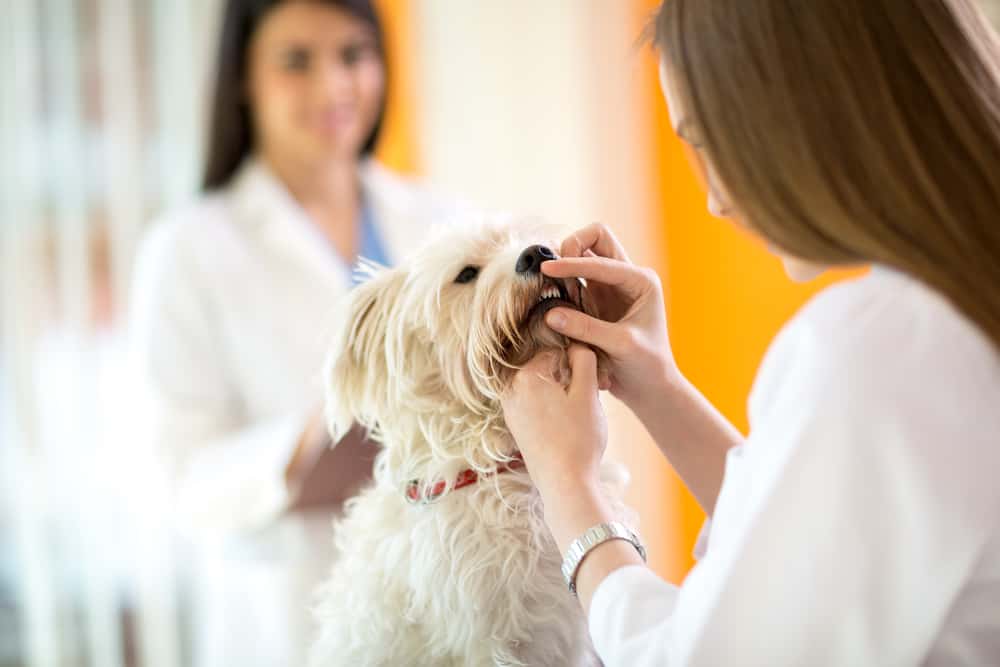Signs of Dental Disease in Dogs
Signs of Dental Disease in Dogs
A puppy pooch smooch is the best but when you have an adult dog with stinky breath getting up close and personal is not so mutual anymore. One of the most common oral issues for dogs is bad breath. While smelly breath may seem harmless or put down to diet, it’s typically a warning sign that a more severe dental disease is occurring in your dog’s mouth.
If your dog has bad breath, you may think it’s due to cavities but more often than not it’s an early warning sign of one of the most common dog dental diseases known as periodontal or gum disease. Periodontal disease is caused by plaque build-up and affects approximately 80% of dogs by the time they are three years old.
At Port Road Vet, we see dog dental disease often. Contact us if we can help you and your pet.

Is periodontal disease serious?
Canine periodontal disease is one of the most common oral gum diseases and can cause serious health complications. This oral infection is caused by the bacteria found in dental plaque, and the first signs typically start with tooth discolouration where plaque builds up and becomes hard tartar. While you can see the tartar above the gum line, it’s what’s happening under the gum that’s of greater concern. Bacteria becomes trapped, and an infection begins to damage the supporting tissues around the tooth.
A chronic bad breath is known as Halitosis. This is something that cannot be cured with a chewy or doggy mint, and unlike a rawhide bone smell that goes away after a while, Halitosis persists and is an indication that you need to see a vet.
We have listed a few signs that will indicate potential gum diseases. If you notice any of these symptoms, take your dog to your vet for an oral examination. Diagnosing periodontal disease early will prevent further pain, tooth deterioration and costly surgical procedures.
- Have bad breath
- Have red, swollen or bleeding gums
- May be reluctant to eat harder foods or refrain from eating at all
- Pawing at the mouth
- Swelling around the face as a result of a tooth abscess
- Your dog may drool excessively
- Behavioural changes such as lethargy, restlessness, which may be considered by some pet owners as normal ageing, changes
If you are also a cat owner you will notice very similar signs and symptoms to a cat who suffers from gum disease things like behavioural changes and aggression associated with pain. If a dog’s breath suddenly has an unusual odour, it may be a good idea just to visually search his mouth for any food that may have become lodged between the teeth and check for broken or loose teeth. If any growths are detected inside the dog’s mouth, it may well be a tumour so get your vet to do an oral examination to make sure.

How Are Canine Gum Diseases Treated?
The treatment will depend on the complexity, severity and progression of the oral disease. Your vet will polish and scale your dog’s teeth to remove the bacterial plaque build-up and if required, surgically extract affected teeth to prevent adjacent teeth from becoming infected.
If your dog has been diagnosed with a through-tooth abscess, it means that the infection or abscess has infected the bone, which is a serious condition. This treatment plan will require a long course of antibiotics and extraction of the affected teeth. Your vet will provide you with a course of anti-inflammatory medication to reduce any swelling and pain.
If your dog has an oral tumour, your vet will need to take a biopsy to comprehensively diagnose the cause and type of tumour to formulate an effective treatment plan. In some severe cases, due to the tumour location, we have had to remove part of the jaw to prevent further deterioration and alleviate pain. Periodontal disease is a painful infection that can spread through your dog’s body affecting the kidneys, liver and heart.
The key to preventing gum disease in dogs is to have an excellent regular oral hygiene routine. All dog breeds are susceptible to gum disease, and statistically smaller dogs are particularly prone to oral issues because of their smaller mouths and hard to reach places. Plaque needs to be removed regularly to ensure the gums stay healthy. Prevention requires professional veterinary dental cleanings and good home hygiene habits like
- Brushing teeth with a toothpaste specifically formulated for dogs
- Feeding high-quality kibbles
- Provide hard chew toys and greenies to help naturally clean their teeth
Canine Dental Hygiene And Preventative Care
Preventative care is a money-saver, because with regular brushing and routine cleaning you can reduce your dog’s risks from developing a serious canine gum disease. Gum disease is the most common oral health problem affecting dogs and keeping their teeth and gums healthy is as essential for them as it is for us. So, if you need extra help brushing and cleaning your dog’s teeth, call your vet. Dogs very seldom show pain before it’s too late. So, schedule regular oral hygiene check-ups as part of your pet care routine because prevention is how we keep our companions healthy and happy.
For more information about pet dental care, contact us on (08) 8340 0388

